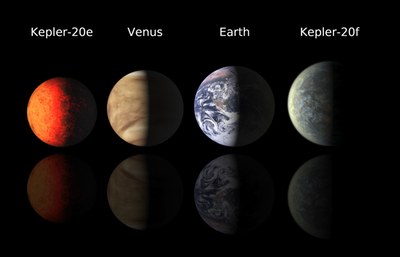Reporting Kepler 20e and 20fby John Hickman
|
| What distinguished the best reporting was that it portrayed science as advancing by offering tentative rather than final answers to questions and by solving puzzles suggested by anomalous new findings. |
For example, after the obligatory reference to the probability of extraterrestrial life—the one element common to every article surveyed for this column—Brian Verstag’s article in the Washington Post first described the surprising discovery that small, rocky planets were interspersed with “larger, gassy” planets orbiting Kepler 20 and then explained that extrasolar planets are identified when astronomers observe that light from a star “dims, or winks.”1 Eric Berger’s article in the Houston Chronicle made these ideas by describing the planetary distribution as alternating between “big, little, big, little, big” and that extrasolar planets are observed as “blips in the light data.”2
If those articles seemed too simple, consider Bill Hutchinson’s unfortunate little article in the New York Daily News, which described the findings as a “sighting,” terminology normally used for UFO reports, and reduced the scientific enterprise to “hunting the heavens for extraterrestrial life.”3
What distinguished the best reporting was that it portrayed science as advancing by offering tentative rather than final answers to questions and by solving puzzles suggested by anomalous new findings. Eryn Brown’s excellent article in the Los Angeles Times devotes 687 of its total of 794 words to elaborating on the puzzle presented by the unexpected planetary distribution.4 She quotes Harvard University’s David Charbonneau not only about the overturning of expectations but repeats his speculation that the three larger planets previously detected in the system might not be gas giants but instead rocky worlds with hydrogen atmospheres.
The best that the British print press offered was Alok Jha’s article in The Guardian, which focused on the possibility of life on Kepler 20e and 20f and the detection of extrasolar planets, but neglected to explain the puzzle presented by the planetary distribution.5 The rest of British reporting on December 21 was even less impressive. As shown by Mike Swain’s short article in The Mirror and Paul Sutherland’s shorter article in The Sun, brevity is no prophylactic against inaccuracy.6 Swain’s misdemeanor was to locate the planets in “a galaxy far, far away,” a cheesy Star Wars reference that no doubt contributed to the scientific illiteracy of his readers. Sutherland’s was to locate the planets 3,900 light-years away. Tabloid reporters are held to different journalistic standards and, perhaps, he concluded that the distances of 945 to 1,000 light-years being cited elsewhere seemed insufficiently remote.
Before taking too much patriotic pride in the superior performance of American newspapers, it is worth considering that many Americans probably learned what little they may ever know about the discovery from CNN. The bantering exchange between anchor T.J. Holmes and meteorologist Rob Marciano captures the tragedy of that truth.7 Before Marciano was allowed to say much about the findings, Holmes pandered to the scientific ignorance and impatience of the television audience: “Got some life out there? Did they find life yet? Hit me up when they find the life. All right?” Alas, Holmes did not elaborate on what he might do with that information.
Endnotes
1 Brian Verstag. “Scientists Discover Two Earth-Size Planets.” Washington Post. December 21, 2011. A03
2 Eric Berger. “New Find Boosts Theory Worlds Like Ours Abound.” Houston Chronicle. December 21, 2011. P. 1
3 Bill Hutchinson. “Are There More Earths?” New York Daily News. December 21, 2011. P. 12.
4 Eryn Brown. Earth Size Planets Orbiting a Faraway Star.” Los Angeles Times. December 20, 2011. P. 10.
5 Alok Jha. “Hots Spots: Two Earth-Like Planets Found.” The Guardian. December 21, 2011. P. 15.
6 Mike Swain. “You Wait 4.5B Years For Another Earth Then 3 Come Along All At Once.” The Mirror. December 21, 2011. P. 24; Paul Sutherland. “Two New ‘Earths’ Out There.” The Sun. December 21, 2011. P. 33.
7 “CNN Newsroom.” 9:00 AM EST.
